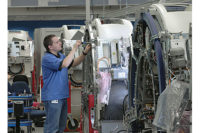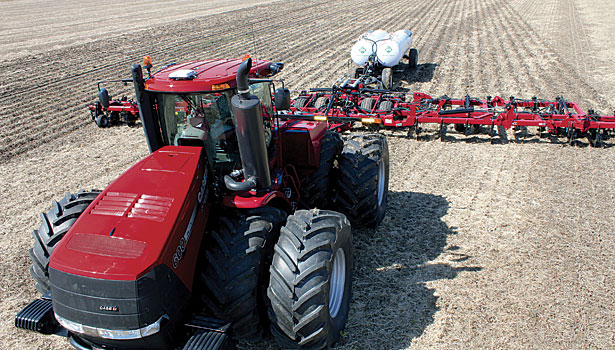Assembling Tractors and Equipment
Today’s machines are lean, strong and smart














Farm tractors haven’t changed much since internal combustion engines started replacing steam power 100 years ago. But, today’s machines are faster, more powerful, lighter, cleaner and smarter than ever. In fact, some large tractors boast more lines of software code than early space shuttles.
Assembly lines are humming at AGCO, CNH, Deere, Kubota and other agricultural equipment manufacturers. The Association of Equipment Manufacturers (AEM) predicts that the North American market will grow 5 percent in 2012. Net farm income is expected to be up 28 percent, while net cash income will grow nearly 19 percent.
“While prospects for the global economy are still volatile, overall the agricultural machinery industry continues to be optimistic that in 2012 key markets, including tractors, will remain at an overall high level,” says Charlie O’Brien, AEM’s vice president agriculture sector.
The global production volume of agricultural machinery for 2011 increased to $98 billion. “Many newly industrialized countries are working toward increased agricultural mechanization,” O’Brien points out. “In developed regions, such as North America and Western Europe, the trend is toward more precision farming, and demand is for the latest technologies and innovations that improve operating efficiencies.”
Among two-wheel-drive tractors, O’Brien predicts most growth for machines in the 40 to 100 hp range. “For other types of equipment, demand is expected to remain in the plus column for most products through 2014,” he explains.
At industry leader, Deere & Co., net sales of worldwide equipment increased 25 percent in 2011 and this year looks equally bright. “In spite of an unsettled global economy, demand for [our] products is expected to experience substantial growth in fiscal year 2012 and the company is forecasting further increases in sales and earnings as a result,” says Samuel Allen, Deere’s chairman and CEO. “Equipment sales are projected to increase about 15 percent for the year and to be up 16 percent to 18 percent for the first quarter compared with the same periods of 2011.”
Many of the tractors rolling down the assembly line at Deere’s Waterloo, IA factory are destined for overseas customers. The same is true at Case IH’s Mount Pleasant, WI, facility that builds the popular Magnum Series tractor. “In 2011, approximately 40 percent of the Magnums produced at the plant were destined for export,” claims Steve Tyler, plant manager.
Case IH, Deere and their competitors use automotive-style assembly lines and world-class lean production processes. However, tractor manufacturing involves much lower annual volumes, less automation on the production floor, longer production cycles and higher manufacturing costs.
“Volumes are obviously lower, while the end product costs are significantly higher,” says Pete Mitchell, off-road segment leader for construction and agriculture at Atlas Copco Tools and Assembly Systems LLC. “Depending on the customer and the model, you generally see volumes of seven to 12 machines on the low end in a week and 100 to 130 tractors on the high side. Comparably, Ford and GM are building a new [vehicle] every 65 seconds or less.
“And, farmers typically have more options available on tractors,” adds Mitchell. “Most tractor manufacturers will build custom vehicles as requested from the customer. For instance, it’s not uncommon to see several dozen different water pump options.”
Tractor components are also heavier, thicker and stiffer than automotive parts, and they must endure higher loads and harsher work environments. “We have seen more demand for high-torque tooling that is flexible enough to be used on several applications in one station,” explains Mitchell. “Additionally, torques and clearances to access these fasteners have always raised concerns and that doesn’t appear to changing anytime in the near future.”
As tractor manufacturers try to reduce their production costs to keep the purchase price competitive in the cyclical marketplace, they are also finding ways to make their products more appealing to their prospective customers. For example, cabins have been outfitted with ergonomic seats and controls, air conditioning, entertainment features and state-of-the-art electronics. The Magnum tractor, which has received several design awards, features a large touch-screen monitor and four-position heated seats.
“Manufacturers recognize the importance of the physical appearance of their machines and have made concerted efforts to eliminate any possibility of rust and corrosion, as well as to improve paint adhesion and durability,” says Steven Vaccaro, focus segment marketing manager at Henkel Corp. “Engineers are focusing on making today’s agricultural equipment more functional than ever to perform better over their long service life.”
Weight Reduction
As tractors get bigger and more powerful, they’ve become heavier. For instance, 50 years ago, Deere’s 4010 row crop tractor weighed 7,100 pounds. Today’s equivalent, the 7280R, weighs more than 27,000 pounds. Early tractors exposed farmers to the elements, whereas contemporary machines have large cabs that contain all the comforts of home, which adds weight.
As tractors get heavier, weight dispersion is becoming an important issue. That’s why tracks are offered as an alternative to tires.
Manufacturers of tractors and other agricultural machinery have been striving to reduce the overall weight of their equipment. “The driving force behind this trend is fuel economy,” says Vaccaro. “Since tractors are designed to last for several decades, fuel economy is an important consideration and a significant portion of the cost of ownership over the life of the equipment. This weight reduction trend is expected to continue for the foreseeable future, especially if fuel prices continue to escalate.”
In reducing the weight of the equipment, OEMs have tried to substitute aluminum, lighter metals and even composite materials for the steel and cast iron that is traditionally used for body and frame components. Where steel or cast iron components must still be used, manufacturers often attempt to reduce wall thicknesses wherever possible without compromising the integrity of the part.
“The use of lighter weight materials can be found throughout the outer body design, operator cabin, and even within many of the accessories and attached implements,” notes Vaccaro. “Along with the usual fastening considerations of structural integrity, vibration resistance, thermal expansion issues and corrosion resistance, this weight reduction initiative brings with it another significant challenge.
“In moving to lighter weight metals or composite materials, components that were once welded together must now be assembled by other means,” adds Vaccaro. “Tractor manufacturers rely on [us] to work along side their engineering departments to design in and provide the optimum product solution to address all their demands and stringent application requirements.”
According to Vaccaro, many manufacturers are moving away from silicone-based adhesives and sealants due to potential contamination inside their production facilities within their painting operations. “Instead, companies are looking to polyurethanes, modified silane polymers and epoxy technologies to replace silicones, and also provide improved aesthetics,” he points out.
Composite materials are engineered to provide the structural strength, impact resistance, temperature tolerance, and UV resistance needed to withstand the demanding workloads and weather conditions found in agricultural applications.
“But, we do not necessarily see the volumes of composite materials like we see being used in the aerospace industry,” says Mitchell. “[Most] applications [are for] cabs and hoods, but not the [chassis]. Lots of heavy steel is still the staple of this industry.”
Despite growing use of lighter materials in the agricultural equipment industry, there’s still plenty of demand for traditional fasteners. “With some materials, welding is no longer an option,” says Bob Corbett, director of engineering and technical services at Alcoa Fastening Systems. “Today, there’s a greater need than ever for mechanical fasteners.
“We’re seeing more demand for high-performance coatings to address corrosion resistance,” adds Corbett. “Agricultural equipment is subjected to a lot of fertilizers and different weather elements. As long as manufactures need to address repair and serviceability issues, fasteners will be widely used.”
The industry is always looking for new ways to solve old problems. “We have seen an influx of former Chrysler, Ford and GM engineers find employment in the agricultural equipment market and they have brought their expertise with them,” says Mitchell. “They are sometimes shocked to see which applications are considered critical or safety-critical and then how tractors are assembled. Torque is much higher in tractor manufacturing. It’s not uncommon to see 4,000 newton-meter tools.
“Low-profile, high-torque tooling is in demand,” claims Mitchell. “So is cordless tool technology that eliminates trip hazards and allows easier access to restricted clearance areas. We are also seeing more customers looking for turnkey solutions. DC nutrunner demand has increased, as well.”
Hands-Free Future
Recent advances in robot reliability and deployment cost, coupled with changing labor demographics, has sparked growing interest in autonomous agricultural equipment. Engineers around the world are busy developing a wide variety of robotic devices for seeding, tilling, weeding, spraying and harvesting applications.
The same technology used for military applications will soon be applied down on the farm. AGCO, Deere and other companies have already created driverless tractors equipped with state-of-the-art computers, lasers, sensors, GPS systems and machine vision technology.
Later this year, Japan plans to unveil the world’s first unmanned farm in the tsunami-ravaged northern part of the country. The 618-acre facility will feature robotic tractors.
“R&D projects have been in place for many years by a number of OEMs,” says Michael Gomes, director of marketing at Topcon Precision Agriculture, a leading supplier of satellite-positioning and guidance systems. “Over the next three to 10 years, we believe various aspects of machine automation will become more integrated with machine function and less operator control, as a way to simplify operation to improve efficiency and minimize risk and loss.”
This will allow farmers to speed up operations to the maximum velocity that conditions will allow and coordinate functions when machines are in close proximity, such as during harvest applications. While the technology exists, numerous challenges still need to be addressed by engineers.
“A major challenge is the development of a tractor controller that matches the driving skills of a human driver,” says Wim Symens, program leader for energy-efficient machines at Flanders Mechatronics Technology Centre. “Cultivating a field with high precision requires a lot of experience to handle the variations in the operational conditions that can occur on the field, such as varying state of the soil, slope of the field, weight of the machine, or interaction between the ground and the implement.
“Based on sensor measurements, such as positioning measurements through GPS, the machine controller constantly needs to estimate the state of these operational conditions and adapt its steering behavior to it,” explains Symens. “As this is a very complex task, tuning such a controller beforehand to cope with all possible situations cannot be done. Therefore, a special advanced controller is required that learns the optimal control behavior of the tractor along its current trajectory.”
AGCO engineers have developed a system called GuideConnect that allows two tractors to communicate to each other. “One operator can now do twice as much work every minute, every hour, every day,” claims Helmut Endres, senior vice president of worldwide engineering at AGCO.
“GuideConnect is largely an integration of existing technologies such as GPS-assisted steering and radio communication,” says Endres. “GPS-assisted steering requires satellite signal receivers, various motion and position sensors, a means to control the machine’s steering mechanism and, of course, computer programmable controller technology to process inputs and output steering control signals.”
AGCO’s Fendt brand plans to offer GuideConnect on its 900 Vario Series tractors in Germany during the later part of this year. Engineers at CNH and Deere have developed similar technology that allows tractors to automatically communicate with each other.
Fully autonomous farm vehicles may be a few more years down the road. But, Kinze Manufacturing Inc. recently demonstrated an autonomy project that’s aimed at planting and harvesting applications. Working with Jaybridge Robotics, Kinze engineers modified one of their grain carts and a Deere row crop tractor. The goal of the project is to increase productivity for corn and soy bean farmers.
“We applied an integrated suite of low-cost sensors, industrial embedded computer and advanced algorithms,” says Jeremy Brown, president of Jaybridge Robotics. “The driverless system is fully controlled by advanced software and is capable of performing a complete workflow during the harvest process.
“This includes locating a moving harvester in the field, synchronizing with it, collecting its grain and delivering that grain to trucks near the field for transportation,” adds Brown. “The trend toward autonomous solutions in mining, defense and other industries will have a profound affect on agriculture.”
“[This is] the first truly autonomous row crop solution on this scale in the world,” claims Susanne Veatch, vice president and chief marketing officer at Kinze. “The autonomy project is designed to reduce the need for skilled operators by taking the human element out of the tractor cab. [We] plan to market this technology to help growers increase their productivity by allowing them to focus their time and attention elsewhere while performing cursory monitoring of the autonomous equipment.”
While the technology exists, some experts believe it will be hard to convince conservative farmers to invest in unmanned equipment. “Safety is a concern, as are regulations and legal issues,” says David Bevly, a mechanical engineering professor and director of the GPS Vehicle Dynamics Laboratory at Auburn University, who has worked with Deere on some autonomous steering applications. “Some safety issues with sensor failures and redundancy issues [still need to be addressed].”
Web exclusives
Deere Celebrates 175th Anniversary
Unmanned Tractors May Alter Assembly Process
Looking for a reprint of this article?
From high-res PDFs to custom plaques, order your copy today!












